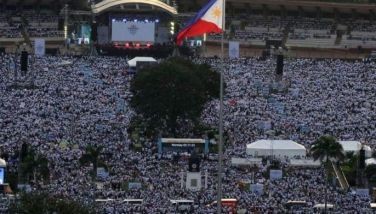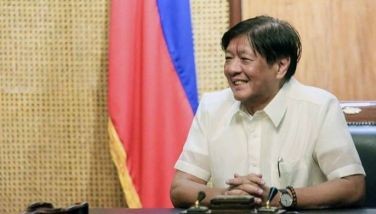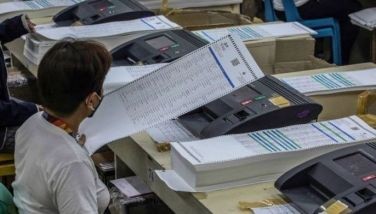Philippines, US vow close coordination on EDCA
MANILA, Philippines - The Philippines and the US have committed to coordinate closely on security and defense initiatives as part of the implementation of the Enhanced Defense Cooperation Agreement (EDCA).
In a joint statement at the conclusion of the Second US-Philippines Two-Plus-Two Ministerial Dialogue in Washington, the two countries also reiterated that EDCA is “consistent” with the Philippine Constitution.
Foreign Affairs Secretary Albert del Rosario and Defense Secretary Voltaire Gazmin met with their counterparts US Secretary of State John Kerry and Defense Secretary Ashton Carter in Washington last Jan. 12 to discuss security issues and work out defense arrangements.
The officials also hailed the Supreme Court for upholding, in a vote of 10-4, the constitutionality of EDCA.
Both parties agreed EDCA would enhance the US ability to provide rapid humanitarian assistance to the Philippines as well as help the Philippine military in its effort to modernize.
“Welcoming the Philippine Supreme Court’s decision that the Enhanced Defense Cooperation Agreement is consistent with the Philippine Constitution, the ministers reaffirmed their commitment to continue strengthening the Alliance, in terms of ensuring both countries’ mutual defense and security as well as jointly contributing to regional peace, stability and economic prosperity,” the joint statement said.
The Department of Foreign Affairs (DFA) said on Tuesday that the Philippines and the US would finalize arrangements for the full implementation of the EDCA.
Joint patrols
In Manila, defense spokesman Peter Galvez said the Philippines is pushing for joint patrols in the West Philippine Sea with the US in the face of China’s growing aggressiveness in asserting its claims in the region.
Galvez said the Philippine panel relayed its proposal to its US counterpart during their 2+2 meeting in Washington.
“The 2+2 meeting extensively discussed the South China Sea issue, with the US side reiterating the US’s ironclad commitment to the defense of the Philippines while the Philippines batted for joint patrols,” Galvez said in a statement yesterday.
Pressed for details, Galvez said the Philippines cited the “need for more collaborative presence in the South China Sea.”
“Thus, in addition to freedom of navigation operations of the US, we are suggesting that we also patrol the area together,” he said.
Galvez said the US reiterated its commitment to support freedom of navigation in the South China Sea, where more than $5 trillion worth of trade passes through every year.
“The US side emphasized that it will not allow China to control the South China Sea and will act to ensure that freedom of navigation is respected,” the defense spokesman pointed out.
“The US also stressed that they will continue to fly and sail whenever and wherever international law allows,” he added.
Furthermore, the US “committed to maintain presence in the South China Sea to include naval, sub-sea, air and special forces,” he said.
China’s territorial claim covers about 90 percent of the South China Sea, a resource-rich area and a busy sea lane that is also being claimed in part by the Philippines, Vietnam, Malaysia, Brunei and Taiwan.
To assert its claims, China launched an ambitious land reclamation program covering at least seven reefs also being claimed by the Philippines.
China is building facilities on Panganiban (Mischief), Zamora (Subi), Kagitingan (Fiery Cross), Kennan (Chigua), Mabini (Johnson South), Burgos (Gaven) and Calderon (Cuarteron) Reefs.
Satellite photos showed the Chinese constructing artificial islands with airstrips, radar systems and military barracks.
In 2013, China declared an air defense identification zone over the East China Sea. The policy requires all aircraft to report their flight plans and to identify themselves while flying through the zone. China has also been challenging non-Chinese aircraft flying over the South China Sea.
Galvez said the US has also reaffirmed its commitment to help the Philippine military carry out its modernization program.
Standardized definition
Citing China’s promise that it would not militarize the South China Sea, Galvez said the US had suggested the need for claimants to have a common and shared understanding of the term “militarization” to avoid miscalculation.
“A common sense among the other parties would put pressure on China,” Galvez said.
The Philippines and the US also agreed to explore the possibility of inviting other partners like Japan and Australia to get more involved in bilateral exercises and similar activities.
“The Philippine side stressed that the involvement of other parties in these activities shall be in accordance with the Philippines’ national legal framework,” Galvez said.
Sen. Antonio Trillanes IV, meanwhile, said EDCA would definitely be mutually advantageous to the US and the Philippines.
Trillanes, chairman of the Senate committee on national defense and security and a vice presidential candidate, said that there is no truth to the claim that the country is giving up its sovereignty by allowing US troops to set up military bases under the EDCA.
In a roundtable discussion yesterday hosted by TV5, Trillanes explained that the US government would spend for the development of the bases and would use these as long as EDCA is in force.
He stressed the bases would remain the property of the Philippines and would eventually be utilized by the country’s forces.
In addition, Trillanes said EDCA would provide the Philippines with a security blanket, which he said is priceless.
He said the presence of US troops would also deter other countries from bullying the Philippines.
“When push comes to shove then you know that we have someone to lean on,” he said.
Mixed reactions
In Pampanga, the proposal to use Clark Freeport as one of the camps for US forces has drawn mixed reactions from business leaders.
Former Clark International Airport Corp. (CIAC) chairman Nestor Mangio told The STAR that the use of Clark by the US military would “compromise our dream of a premier international gateway.”
“I am not against an alliance with the US military amid the territorial dispute with China, but why should Clark, which is now a freeport, be offered for US military use? There is Basa air base that can be used instead,” said Mangio. Basa air base is in Floridablanca, Pampanga.
Mangio noted that congestion at the Ninoy Aquino International Airport (NAIA) has increased awareness of the need to use the Clark airport as alternative airport.
“Now that we know the value of Clark as alternative to NAIA, why complicate the situation by opening it to US military operations?” he asked.
“While part of Clark is under the Philippine Air Force, there is no doubt that its two runways would be shared with the US military and therefore disrupt civilian aviation,” he added.
But Rene Romero, chairman of the Pampanga Chamber of Commerce and Industry and an official of Central Luzon’s Regional Development Council, said he is in favor of the proposal.
“We need them at this time. We still do not have enough capability to defend our territory against China, so we need an ally and the US has been a close ally for a long time,” he said.
Romero also noted that part of Clark is within the jurisdiction of the PAF and its use by the US military under the EDCA is legally acceptable. – With Marvin Sy, Ding Dervantes
- Latest
- Trending




























